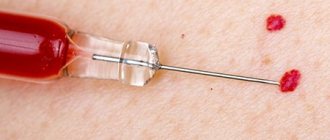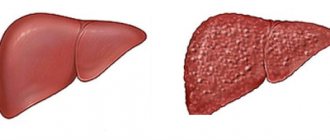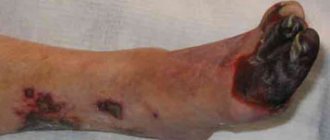Aching, headache... How often do we have to talk about this. And sometimes a person does not attach importance to the onset of a migraine, attributing his poor health to a sharp change in temperature, pressure changes, age, or simply to his own fatigue or lack of sleep. Most people take headaches for granted and do not consider it a problem. But, in fact, such a harmless symptom may hide processes that are dangerous to the body. For example, discirculatory encephalopathy. Simply put, it is a narrowing of blood vessels in the brain. Due to the narrowing, blood does not flow to the brain in sufficient quantities. And if a large area of the brain is damaged by this process, a “harmless” headache or dizziness can lead to ischemia.
Causes of vasoconstriction
Vasoconstriction, also called stenosis, is familiar to a large number of people, especially those who spend a long time at the computer for work. But constant overstrain of the anatomical structures of the neck in a sitting position is far from the main cause of the development of pathology. There can be a lot of reasons, and they are divided, first of all, into:
- Congenital.
- Purchased.
We need to look at the reasons in more detail.
Congenital pathology
In the first case, narrowing of the vessels of the cervical spine is preceded by congenital hypoplasia of the veins and arteries of the cervical spine, as well as stenosis of the carotid arteries and disorders in the development of the spine in this area, vertebral arthrosis. Congenital causes may occur due to:
- distribution of toxins throughout the pregnant woman’s body;
- injuries to a pregnant woman;
- infection of the expectant mother's body.
In general, any stressful situation for a pregnant woman’s body can result in abnormal development of the fetus.
Purchased
In the case of acquired causes of the development of pathology, it is worth noting that the development of the disease is provoked by: atherosclerosis, a decrease or increase in blood pressure, an increase in blood sugar levels, injuries and hernias in the cervical spine, as well as various tumors. In addition, the disease can appear with intense mental or physical work, neglect of sports and even minimal physical activity, bad habits and stress.
Signs of cerebral vasoconstriction
There can be many reasons for the narrowing of blood vessels in the brain. But, you should pay attention specifically to the forms of the already established disease: initial and chronic. It is difficult to judge which of them is most dangerous for the human body. Because the chronic form can plague a person for years, and the initial form can lead to death at the very first stage.
That is why it is so important not to miss the first “bells” of the onset of the disease.
So, the following signs should alert you:
- functional disorders of the central nervous system (fatigue, migraines, unexplained irritability, tearfulness, overexcitation, touchiness);
- incipient memory problems (short-term forgetfulness, inability to remember what happened a few minutes ago - the name of the program, the location of the keys, etc.);
- change in gait (a person shuffles his feet or minces heavily);
- the appearance of a false urge to urinate;
- loss of coordination of movements, loss of balance;
- development of dementia;
- malfunctions in the functioning of internal organs located in the pelvic area.
Symptoms
Symptoms of vasoconstriction in the cervical spine do not appear for a very long time, and a person with this disease does not notice any deterioration in well-being. However, later in the development of the disease it begins to manifest itself:
- constant dizziness;
- lack of strength even with constant rest;
- sudden loss of consciousness for no reason;
- flickering before the eyes;
- noise or ringing in the ears;
- pressing or aching pain in the head, particularly in the back of the head, may spread to the neck.
In general, two groups of symptoms can be distinguished. The first group includes manifestations that reduce a person’s level of performance, but do not lead to a desire to visit a doctor. The second group includes obvious pain manifestations and symptoms that indicate significant blockage of blood vessels and the need for urgent hospitalization of the person.
Symptoms of atherosclerosis
Atherosclerosis begins unnoticed.
A person cannot feel that plaque has formed on the walls of the arteries until it has become a significant obstacle to blood flow. But with the help of instrumental diagnostics, atherosclerotic changes can be detected even at an early stage. Recent research shows that atherosclerotic artery disease can be found in most people aged 30 years and older. With age, the risk of developing atherosclerosis increases. At the same time, men suffer from atherosclerosis several times more often than women.
The manifestations of atherosclerosis vary depending on which arteries are most affected.
Atherosclerosis of the aorta
(the main vessel of the arterial system) usually leads to arterial hypertension (persistent increase in blood pressure). A characteristic sign is, first of all, an increase in systolic pressure (that is, the first, larger numerical indicator when measuring pressure).
Atherosclerosis of heart vessels
is the main cause of coronary heart disease (CHD). The most common form of coronary artery disease is angina pectoris, which manifests itself in the form of chest pain, usually of a pressing nature, as well as (in some cases) shortness of breath, weakness, and increased sweating. Atherosclerosis of the heart's own vessels can lead to the development of myocardial infarction, heart defects, and heart failure.
Atherosclerosis of cerebral vessels
may manifest itself with symptoms such as memory impairment, decreased attention, dizziness, tinnitus, and sleep disturbances. Complete closure of the vessel threatens ischemic stroke (death of part of the brain tissue due to impaired blood supply).
Symptom of atherosclerosis of the vessels of the lower extremities
is intermittent claudication. Intermittent claudication is pain in the calf muscles that causes you to stop walking. Once you stand and the pain goes away, you can continue to move on. Further development of the disease leads to pain in the calf muscles at rest and the appearance of trophic ulcers.
Atherosclerosis of the renal arteries
manifested by increased blood pressure (as well as atherosclerosis of the aorta).
Atherosclerosis of the arteries of the upper extremities
It is quite rare and manifests itself as weakness in one or both arms.
Atherosclerosis is a systemic disease, that is, if atherosclerotic lesions are detected in the arteries of one area, the development of atherosclerosis in other arteries is very likely.
Increased blood pressure
Manifests itself in atherosclerosis of the aorta
and
atherosclerosis of the renal arteries
.
Chest pain
It manifests itself in atherosclerosis of the heart vessels in the form of pain behind the sternum, usually of a pressing nature.
Dyspnea
Occurs in some cases with atherosclerosis of the heart vessels
.
More about the symptom
General weakness
Occurs in some cases with atherosclerosis of the heart vessels
. Weakness may be accompanied by increased sweating. The patient "breaks into a sweat."
Heartbeat disorders
Also for atherosclerosis of heart vessels
Heart rhythm disturbances may occur, so a feeling of accelerated or irregular heartbeat may also be a sign of atherosclerosis.
Memory impairment
Impaired brain activity may manifest itself in the form of memory loss or decreased ability to concentrate.
Dizziness
Dizziness may be one of the symptoms of cerebral atherosclerosis
.
Noise in ears
Manifests itself in cerebral atherosclerosis
.
More about the symptom
Sleep disorders
May be observed in cerebral atherosclerosis
.
More about the symptom
Intermittent claudication
Manifests itself in atherosclerosis of the vessels of the lower extremities
. The patient is forced to stop while walking due to pain in the calf muscles. In order to continue moving, you need to stand in one place and wait until the pain goes away.
Weakness in the hands
Weakness in one or both arms may indicate atherosclerosis of the arteries of the upper extremities
.
Diagnostic methods
Neurologist
It is not enough to interview and examine the patient to identify narrowing of the blood vessels of the spine; in any case, additional examinations will be prescribed. These include:
- Duplex scanning
- despite the fact that this is a rather dangerous diagnostic method in this situation, it is informative and accessible, it allows you to determine the degree of narrowing and its nature. - Angiography - the process uses a contrast agent to examine the vessels.
- and MRI
- allow you to obtain layer-by-layer 3D images, with which you can make a diagnosis.
All this will allow the doctor to determine not only the patient’s health status, but also the reasons that led to the occurrence of stenosis.
Treatment methods for atherosclerosis
Effective treatment of atherosclerosis must be comprehensive and include both drug and non-drug methods.
Drug therapy
Drug treatment for atherosclerosis is primarily aimed at reducing the synthesis of cholesterol by the patient’s body, reducing its intracellular content, enhancing the removal of cholesterol and its metabolites from the body, and inhibiting the absorption of cholesterol in the intestine.
Non-drug treatments
Non-drug treatment of atherosclerosis is aimed at eliminating modifiable factors of the disease. First of all, this:
- quitting smoking and alcohol abuse;
- normalization of body weight;
- proper nutrition. It is necessary to reduce the consumption of foods high in cholesterol (it is advisable to avoid fatty and fried foods). The optimal menu should contain a significant amount of vegetables and fruits rich in fiber and vitamins. And meat can (and should) be replaced with fish;
- increasing physical activity. Physical activity is necessary, but it must be dosed (agreed with your doctor). It is also important to ensure that the body receives enough oxygen (it is optimal to exercise in the fresh air);
- exclusion of conflict situations and overwork (anti-stress psychotherapy).
Make an appointment Do not self-medicate. Contact our specialists who will correctly diagnose and prescribe treatment.
Rate how useful the material was
thank you for rating
Treatment
The method of treating narrowing of blood vessels in the cervical spine is prescribed depending on the degree of progression of the disease. The earlier the condition is detected, the easier it is to get rid of it; in the later stages, only surgery is indicated.
Drug treatment
It is prescribed if the manifestations of stenosis are not yet very pronounced. In such a situation, the patient will have to take a large number of medications, among which will be:
- antioxidants;
- vasodilators;
- statins;
- fibrates;
- antidepressants.
Treatment with medications for vasoconstriction of the cervical spine involves quickly relieving pain and stopping the progression of the disease.
Operation
If the doctor determines vascular spasm and their occlusion by more than 70%, only surgical intervention will be indicated. There are several options to solve the problem:
- Carotid endarterectomy - the vessels are “cleaned” of plaques by scraping them out.
- Angioplasty - the lumen of the vessel is increased thanks to a special catheter.
- Stenting - a special frame is installed, which leads to straightening of the narrowed section of the vessel.
The possibility of performing each type of operation is determined by the doctor individually, since each type has its own indications and contraindications. Everything will depend on the diagnostic results.










